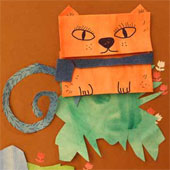Pre-production means making the blue print of the animation which is further divided into:
a) Story and Story Boarding
b) Cut-out requirements
c) The Stop motion stand
d) Stop motion Camera.

a) Story and Story Boarding:
An animation movie can recreate an imaginary world. One could even write a few sentences for an animation short. It doesn’t need to have an elaborate thinking process involved in sci-fi movies; on the contrary it could be funny or dream like. For instance, bees buzzing, or taking in the nectar of lotus flowers, frogs are also in search of the food, simple sentences like these could be the inspiration for a paper cutout animation.

Character design, size, background, the staging of character in a particular frame and the animation needs to be finalized in this stage. One needs to sketch almost everything whatsoever is going to be captured in the frame, like the character’s poses or expressions provided whether the details are required or not, background and the staging of character with respect to background.

Always make 4 to 5 iterations of the character design and background, this is where you can imagine and bring out the unusual.
While sketching the drawings, keep in mind the aspect ratio. Follow the same aspect ratio by drawing inside the blocks of the ratio you want like 4:3 or 16:9.
For more information regarding aspect ratio you can check –
Design course on Animation Technicalities on http://www.dsource.in
Storyboarding supplies the animator with full information about the animation; hence the preparations should be done in the start of the project. After writing a story, a storyboard is prepared, which gives a rough idea of the placement, size and timing of the animation. It is important to know that a good visual enhances a story, so keep the story simple, because a well timed animation gives a much more better result.

b) Cutout Requirements:
Paper is the material mostly used for cutout. The paper may be thin or hard, colored or white, printed or even any cardboard could be used for making 2D characters and props etc. Magazine, newspaper and photograph cutouts are available in abundance, which can be used in animation. Fabrics of different texture, color or style can be the other options. One can also experiment with the materials and their visuals; the animator can use anything to maintain the illusion of a 2D surface.

Sometimes magazines or newspaper show white edges owing to the thickness of the edge, color those edges with black marker so they don’t look like of a different frame.


Blue tack is used to glue the different cutout pieces temporarily. Due to its elastic nature it also allows movement for moving frame by frame.


c) The Stop Motion Stand:
The stop motion stand is actually a heavy iron rod stand, standing erect on a wooden board. The stand has a hinge, to attach the still camera, facing downward to capture the frame kept above the wooden board. With this set up good lighting sources and space is essential.

d) Stop Motion Camera:
Stop motion is the technique of capturing cutout animation. A Still camera (Canon/ Nikon/ Sony etc.) is used to which has Prime lens or any 18-55mm lens. The camera setting should be at manual mode so that any light adjustment doesn’t affect the shoot. Customizing the color temperature, ISO, brightness and contrast are some of the important requirements before the shoot. The external light sources are also required to maintain the light sources. Fixing the camera on the stand, framing the cutout work one can start the pose to pose stop motion animation.


